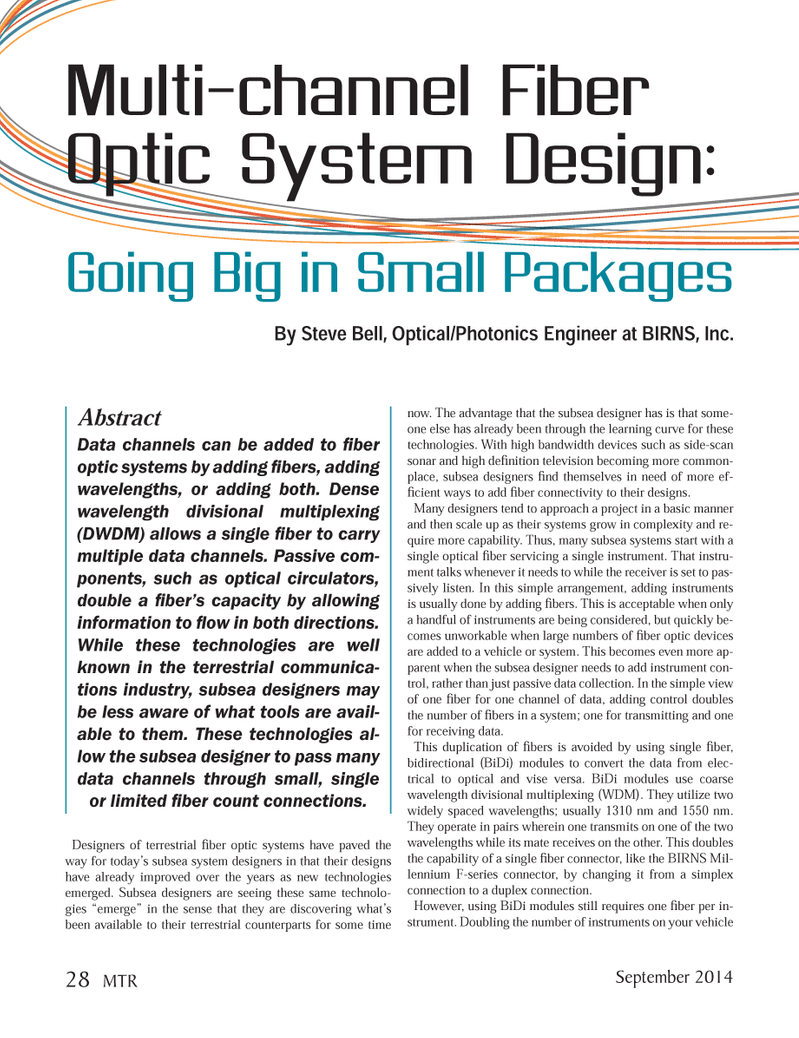
Page 28: of Marine Technology Magazine (September 2014)
Ocean Observation: Gliders, Buoys & Sub-Surface Networks
Read this page in Pdf, Flash or Html5 edition of September 2014 Marine Technology Magazine
Designers of terrestrial fi ber optic systems have paved the way for today’s subsea system designers in that their designs have already improved over the years as new technologies emerged. Subsea designers are seeing these same technolo- gies “emerge” in the sense that they are discovering what’s been available to their terrestrial counterparts for some time now. The advantage that the subsea designer has is that some- one else has already been through the learning curve for these technologies. With high bandwidth devices such as side-scan sonar and high defi nition television becoming more common- place, subsea designers fi nd themselves in need of more ef- fi cient ways to add fi ber connectivity to their designs.
Many designers tend to approach a project in a basic manner and then scale up as their systems grow in complexity and re- quire more capability. Thus, many subsea systems start with a single optical fi ber servicing a single instrument. That instru- ment talks whenever it needs to while the receiver is set to pas- sively listen. In this simple arrangement, adding instruments is usually done by adding fi bers. This is acceptable when only a handful of instruments are being considered, but quickly be- comes unworkable when large numbers of fi ber optic devices are added to a vehicle or system. This becomes even more ap- parent when the subsea designer needs to add instrument con- trol, rather than just passive data collection. In the simple view of one fi ber for one channel of data, adding control doubles the number of fi bers in a system; one for transmitting and one for receiving data.
This duplication of fi bers is avoided by using single fi ber, bidirectional (BiDi) modules to convert the data from elec- trical to optical and vise versa. BiDi modules use coarse wavelength divisional multiplexing (WDM). They utilize two widely spaced wavelengths; usually 1310 nm and 1550 nm.
They operate in pairs wherein one transmits on one of the two wavelengths while its mate receives on the other. This doubles the capability of a single fi ber connector, like the BIRNS Mil- lennium F-series connector, by changing it from a simplex connection to a duplex connection.
However, using BiDi modules still requires one fi ber per in- strument. Doubling the number of instruments on your vehicle
Abstract
Data channels can be added to fi ber optic systems by adding fi bers, adding wavelengths, or adding both. Dense wavelength divisional multiplexing (DWDM) allows a single fi ber to carry multiple data channels. Passive com- ponents, such as optical circulators, double a fi ber’s capacity by allowing information to fl ow in both directions.
While these technologies are well known in the terrestrial communica- tions industry, subsea designers may be less aware of what tools are avail- able to them. These technologies al- low the subsea designer to pass many data channels through small, single or limited fi ber count connections.
Multi-channel Fiber
Optic System Design:
Going Big in Small Packages
By Steve Bell, Optical/Photonics Engineer at BIRNS, Inc. 28 MTR
September 2014
MTR #7 (18-33).indd 28 8/26/2014 11:38:52 AM

 27
27

 29
29
